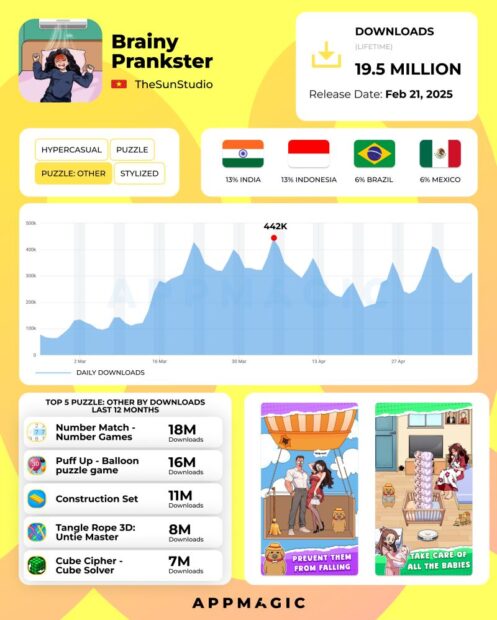
How Social Gameplay Can Help Your Game Grow At Every Stage
Journal 5 Ahmetcan Demirel May 11
Social gameplay is often treated like a final boss in game development. It’s the cherry on top that studios promise themselves they’ll add once they’ve made it. And as Adam and Laura jokingly mentioned on the TWIG podcast some time ago, it ends up becoming “social gameplay jazz hands”. A flashy but often empty gesture toward something fundamentally valuable.
It perfectly captured how social layers are often treated as the endgame in a title’s lifecycle. You go through all the necessary steps (building, launching, scaling) and if you’re lucky enough to end up with a game that gains traction and shows evergreen potential, then and only then are you “supposed” to start thinking about social features.
But that mindset limits what social gameplay can actually do for a title. What if, instead of being an afterthought, social mechanics were baked into a game’s DNA from day one? Not as a fully fleshed-out system, but as scalable pillars that grow with your game?
Contrary to popular belief, adding social features doesn’t have to require a robust tech stack or a massive user base. You don’t need guilds, chat, or an MMO-style community to start being “social.” What you do need is a layered, iterative mindset, which you probably apply towards building your game itself.
Tier 1: Leaderboards
You can have the most barebones game in the world and still build a layer of social engagement. Leaderboards are that entry point.
This became especially evident during the rise of Hypercasual games. Voodoo’s Aquapark.io was a milestone here. Not because it introduced leaderboards, but because it showed how powerful even a fake leaderboard could be. That post-level leaderboard view created a moment of imagined competition that elevated retention.
It worked so well that other Hypercasual publishers quickly adopted it, and before long, leaderboards became all the rage for publishers and developers alike. But here’s the bigger lesson: even when your game doesn’t have deep mechanics, social framing adds meaning. Competing against others, even passively, taps into one of the oldest motivators in gaming.
Sure, more complex games had been using leaderboards for years, but this shift helped bring the feature into the hands of a much broader range of teams. As the Hypercasual space evolved (and, let’s be honest, died out), leaderboard mechanics transformed alongside it. But one thing stayed the same: you don’t need to build a social network to give players a sense of social connection.
Of course, there are far more creative ways to leverage leaderboards. Even games with deeply social ecosystems are running what we now recognize as leaderboard-driven events:
- Target-based events, like Knight’s Race in Homescapes, where players compete against a limited group to hit score milestones first. These events make competition more intimate and achievable.
- Time-based events, like Monopoly GO!’s daily tournaments, add rhythm to your game. They create predictable windows of tension and release, encouraging habitual play.
- Local and global leaderboards, which allow players to measure themselves against their circle and the world. It’s not just about who’s #1. It’s about who’s #7 among your Facebook friends.
What matters most at this stage isn’t the depth of competition, but the existence of it. Leaderboards signal that your game isn’t a vacuum, that other people exist, and they’re trying too.
Tier 2: LiveOps
Once you’ve proven that competitive tension works in your game, the natural next step is to expand the structure. Not just the leaderboard itself, but the context around it.
LiveOps lets you do that, which already was a part of the previous tier. It’s not just “more leaderboards”, but events that blend competition with variety, narrative, and surprise. Many of these events still include some form of leaderboard at their core. And really, isn’t anything with rankings just a leaderboard in disguise? But let’s move on.
As mentioned briefly in a previous piece, some of your players are deeply motivated by competition. And in a game that’s inherently single-player, giving those players the competitive outlet they crave isn’t always straightforward. But don’t assume you need a 4X strategy game to make head-to-head play work. Different types of competitions can live comfortably even in the most casual setups.
- 1v1 competitions are one example and you can find lots of them in many games. One smart execution of this is Model Matchup in Project Makeover, which pits you against another player in a timed competition to score more points. It’s not 1v1 in real-time, but it feels like it. You’re not just playing for prizes, but you’re playing to beat someone.
- Win streak mechanics also work really well within this setup. Candy Royale in Candy Crush Saga turns a run of level wins into a shared gauntlet. The moment you lose, you’re out. And that sense of shared elimination among a hundred players generates serious stakes. Even if you’re not actively chatting, you feel the presence of others.
- Cooperative events have also become quite popular lately, where instead of trying to outpace others, you team up. Partner-based events where players sync up to win shared rewards work especially well if you’ve already implemented teams. If you happen to offer player chat as well, then it becomes all the better since your players could really plan how to move forward.
At this stage, social gameplay starts bleeding into your game loop. The events don’t just decorate the experience. They reshape how players approach it.
Tier 3: Teams
While leaderboards and events simulate social pressure, teams turn it into a real dynamic. When players can join persistent groups, the social fabric of your game shifts.
First off, just like the events above, team tournaments where groups go head-to-head are a powerful way to give players another outlet for social interaction. These events bring teammates together while also pitting them against other teams, effectively hitting two birds with one stone by reinforcing both cooperation and competition.
Teams also introduce what I like to call the expectation layer. In nearly every team-based game, a familiar pattern emerges: highly committed players nudge their teammates to contribute more. It’s subtle at first. Maybe a reminder in the chat, maybe a passive-aggressive emoji. But it’s powerful.
Even casual teams form their own internal standards. The unspoken vibe becomes, “If we’re going to win this event, we need everyone pulling their weight.” That expectation drives re-engagement better than any notification ever could.

However, this mechanic cuts both ways. Peer pressure can become toxic. That’s why you need guardrails:
- Reward even the smallest contributions to prevent disengagement.
- Allow players to opt into casual vs. competitive teams based on their playstyle.
- Provide tools for reporting and managing negative behavior.
Handled well, teams don’t just increase engagement. They change what your game is. In many top-grossing casual titles, players stay not because of the core gameplay, but because of the friendships and rivalries they’ve built inside those teams.
Over time, I’ve seen players form real connections. Teammates talk about sick kids, bad days at work, even personal grief. These aren’t just gamers anymore. They’re a micro-community. And the game becomes the shared space that holds them together.
Build for Belonging, Not Just Play
For too long, social gameplay has been seen as a luxury. A milestone reserved for breakout hits with millions of DAUs and massive LiveOps pipelines. But the reality is far more actionable. As mentioned several times now, social mechanics aren’t the final layer of a game’s success story, but they’re part of what gets you there.
We’re no longer in the era where ultra simple Hypercasual titles can thrive with minimal engagement hooks. Even the most basic Hybridcasual games are now expected to offer more. More reasons to return, more opportunities to connect, more ways to care. That shift in player expectations makes it even more critical to treat social gameplay as something that starts early, scales gradually, and evolves alongside your audience.
The good news is, you don’t have to start big as we saw just now. A leaderboard is enough. A time-limited event can change how players perceive your game. A lightweight team system can create real bonds between strangers. These aren’t massive investments. They’re small, smart bets on your game’s longevity.
Social features won’t guarantee success, but they act as engagement insurance in an increasingly tough market. When done right, they give your players something to return for beyond content drops or monetization offers. They create belonging, and belonging is sticky.
So don’t wait until your game is “ready” to be social. Make it part of the DNA from the very beginning. Because the most successful games aren’t just built to be played. They’re built to be shared.






